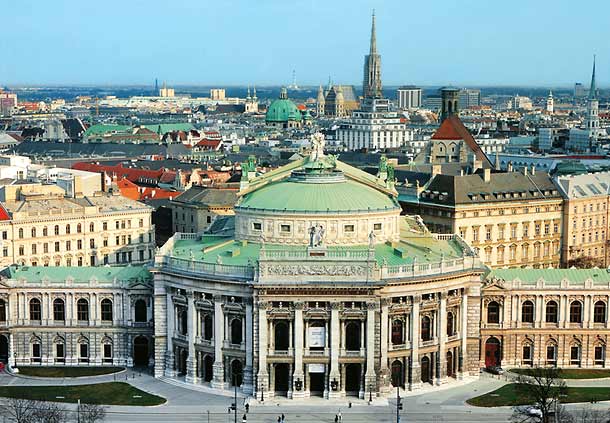Between
the two World Wars, Vienna involved leading architects in social housing
projects that came to dominate the character of some Viennese neighborhoods.
World War II caused major damage to the city, and the reconstruction phase
lasted well into the 1960s.
 |
| State Opera House http://www.aeiou.at/aeiou.photo.data.text.fw32/fw17366h.hts;internal&action=_setlanguage.action?LANGUAGE=en |
 |
| Burgtheater http://klio.uoregon.edu/ViennaCity.html |
After
the war, Vienna was part of Soviet-occupied Eastern Austria until September of
1945. During this time, Vienna was
divided into sectors by the four powers: USA, UK, France, and the Soviet
Union. This four- power control of
Vienna lasted until the Austrian State Treaty was signed in May 1955. That year, after years of reconstruction and
restoration, the State Opera and the Burgtheater, both on the Ringstraße,
reopened to the public. Although the
Treaty of Vienna permitted economic and political consolidation after a decade
of division into four zones of occupation, the city still lacked a real
migration field and lost much of its international character since it could no
longer draw on a spectrum of ethnic migrants: the city’s population became more
“provincial’ in the post-war era. Vienna
occupies the position of a very complex irregular border for the transfer of
capital, information, and people.
In
Austria, there is a long tradition of measures for the preservation of
historical buildings and townscapes.
Major activities in this field started early in the 1960s in
Vienna. There were two trends:
renovation and remodeling. First of all
attempts were made to beautify the facades of the most ancient building stock,
and to restore staircases, corridors and courtyards
In the 1970s, Austrian Chancellor Bruno
Kreisky
inaugurated the Vienna International Centre, a new area of the city created to host
international institutions. At the same
time a new approach to preservation evolved, and the old town was legally
protected in 1972.
From
the 1960s, quite different economic projects were financed, such as the
development of industrial sites and the establishment of shopping centers. During the following decade a reorientation
of housing policy took place. After a
half century of municipal housing programmers this task was transferred to
cooperatives, while the municipal authorities revived their priorities of the
late Founders’ Period: urban design and development of the technical infrastructure. Ambitious large scale projects were carried
out, such as refuse incineration plants, power stations, gas works, the
construction of a second channel for the Danube, and , together with it, the
creation of Vienna’s largest ever recreation area the “Danube Island”.
 |
| http://www.virtualtourist.com/travel/Europe/Austria/Bundesland_Wien/Vienna-320332/Things_To_Do-Vienna-Ringstrasse-BR-1.html |
The
construction of the underground railway system is still under way. It has been claimed that urban design ought
to be ‘social urban design’ where about half of the city area meanwhile is
municipal property.
Olsen, Donald J. The City as a Work of Art: London, Paris, Vienna. New Haven: Yale UP, 1986. Print.
No comments:
Post a Comment